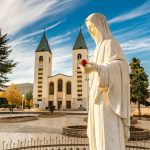The village of Walsingham, tucked into the gentle countryside of Norfolk, England, has been a destination for pilgrims for nearly a thousand years. Long before modern roads and smartphone maps, travelers left the bustle of their lives to walk the quiet lanes leading to a small chapel built to honor the Virgin Mary. Today, the same impulse draws people here: to pause, to pray, and to remember that the divine can be found in the simple act of journeying.
A Brief History Woven into the Land
The story begins in 1061, when Lady Richeldis de Faverches, a local noblewoman, reported a vision of the Virgin Mary. Mary asked her to build a replica of the Holy House of Nazareth in this English countryside. Richeldis obeyed, and the shrine quickly became one of the most important pilgrimage sites in medieval Europe. Kings and commoners alike made the trip, seeking healing, forgiveness, or simply the quiet assurance of Mary’s presence.
The Reformation brought destruction to many holy places in England. Walsingham’s original shrine was dismantled in the 1530s under Henry VIII. Yet the memory of devotion endured, and in the 20th century the shrine was restored—today there is both an Anglican Shrine of Our Lady of Walsingham and the Roman Catholic National Shrine, standing not as rivals but as neighbors. Pilgrims often visit both, a sign of faith’s persistence across centuries and denominations.
What Pilgrims Experience Today
Arriving in Walsingham, you feel the difference in pace immediately. Narrow streets lined with flint cottages lead to gardens and stone chapels. Pilgrims often begin at the Slipper Chapel, about a mile from the village. In medieval times, travelers would remove their shoes here to walk the final stretch barefoot, a sign of reverence. Many still do so, calling it the “Holy Mile.” The crunch of gravel under bare feet, the smell of damp earth, the sound of birds in the hedgerows—it all slows the mind and opens the heart.
The Anglican shrine sits in a tranquil courtyard, with a small Holy House at its center. Candles flicker in quiet chapels; priests hear confessions; visitors kneel in silent prayer. The Roman Catholic shrine, just outside the village, offers its own peaceful grounds and a Slipper Chapel that has become the heart of Catholic pilgrimage in England. Whether you attend a formal liturgy or simply sit in the garden, the sense of continuity with centuries of faith is unmistakable.
Beyond formal worship, pilgrims describe an atmosphere of gentle hospitality. Tea shops and small inns welcome travelers, echoing the tradition of medieval hostels. Conversations with fellow pilgrims—some lifelong believers, others curious seekers—often become as meaningful as the destination itself. Walsingham invites reflection not only on the divine, but on the shared human journey.
Planning Your Pilgrimage
A pilgrimage to Walsingham can be as simple or as structured as you choose. Many begin in London, taking a train to King’s Lynn or Norwich and then a bus or taxi to the village. Others prefer to walk longer routes, retracing historic paths from Ely or from the Norfolk coast.
If you plan to walk the Holy Mile barefoot, bring comfortable shoes for the rest of the trip and a small towel to clean your feet afterward. Dress for the famously changeable English weather: a light rain jacket is almost always wise.
Accommodation ranges from simple guesthouses run by the shrines themselves to cozy bed-and-breakfasts. Booking ahead is important in summer, when pilgrim groups and tourists fill the village. The shrines host regular services, processions, and opportunities for confession or spiritual counseling; check their websites for schedules.
Food in Walsingham reflects English village life—pubs serve hearty stews and pies, while cafés offer scones and tea. Sharing a meal with fellow travelers can become part of the pilgrimage’s quiet grace.
Walking with Intention
Jackson Crawford often reminds readers of the power of landscape and movement to shape the soul. Pilgrimage is not only about the endpoint but the act of walking itself. As you approach Walsingham—whether along the Holy Mile or a longer path—each step can become a prayer. Notice the rhythm of your breath, the texture of the road, the weight of your pack. The journey teaches patience and attentiveness, virtues as old as the faith that first brought people here.
Some pilgrims come seeking healing from illness or grief. Others look for guidance in a time of decision. Many simply want a pause from a noisy world. Whatever your reason, let the journey unfold at its own pace. The shrine is not a place for rushing. Sit in the chapel even after your formal prayers are finished. Watch the candlelight dance on the stone walls. Listen for what silence has to say.
Beyond the Shrine
While the shrine is the heart of the pilgrimage, the surrounding Norfolk countryside adds its own blessing. Rolling fields, quiet woods, and the nearby North Sea coast offer places for longer walks and contemplation. The medieval ruins of Walsingham Abbey, especially when the springtime snowdrops bloom, are worth exploring. These stones, weathered and half-lost to time, remind visitors of the enduring human desire to reach toward the sacred.
A Living Tradition
Pilgrimage to Our Lady of Walsingham is not a relic of the past. Each year, thousands of people—Catholic, Anglican, Orthodox, and others—continue to make the journey. They come with the same mixture of hopes and burdens that drew medieval travelers. The shrine stands as a quiet witness that faith endures, adapting to each new century without losing its heart.
Whether you arrive with a church group, as a solitary walker, or with nothing more than curiosity, Walsingham offers a meeting point of history, landscape, and devotion. The Virgin Mary’s request to Lady Richeldis—a simple house built in honor of the Incarnation—still speaks across the centuries: the divine can dwell in ordinary places, and the journey to find it can begin with a single step.






